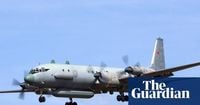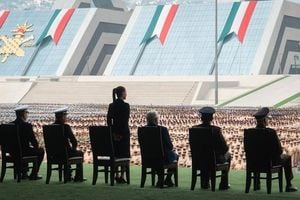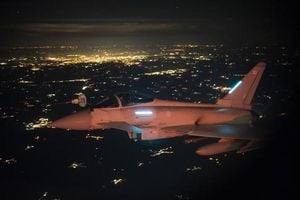On Sunday, September 21, 2025, the skies above the Baltic Sea became the stage for the latest chapter in a rapidly escalating standoff between NATO and Russia. Germany’s air force scrambled two Eurofighter jets from its Rostock-Laage airbase to intercept a Russian IL-20M reconnaissance aircraft that had entered neutral airspace. According to the German air force, the Russian plane was flying without a flight plan, had switched off its transponders, and ignored all requests to make radio contact—a move that immediately raised alarm bells among NATO defense chiefs and European leaders alike, as reported by AP and The Guardian.
The German jets, acting under NATO’s “quick reaction alert force,” visually identified the Russian aircraft before handing over escort duties to Swedish NATO partners. The German pilots then returned to base. This incident, while resolved without direct confrontation, was anything but routine. It came just days after a separate, even more provocative episode: on Friday, September 19, three Russian MiG-31 fighters violated Estonian airspace in the Gulf of Finland, remaining for twelve tense minutes before departing. Estonia’s government, calling the incident “unprecedented and brazen,” swiftly summoned Moscow’s charge d’affaires in protest and demanded urgent consultations under Article 4 of the NATO treaty, which allows for emergency dialogue when a member feels threatened.
The Estonian Prime Minister, Kristen Michal, didn’t mince words, labeling the incursion as “totally unacceptable.” The condemnation was echoed by NATO and European governments, who described the episode as “reckless” and “a dangerous provocation,” according to Reuters. Meanwhile, Russia’s Ministry of Defence flatly denied the allegations. But for Estonia, the stakes had already shifted: it called for an emergency session of the United Nations Security Council, the first such request in its 34-year membership, as reported by The Guardian.
Estonian Foreign Minister Margus Tsahkna set the incident within a broader pattern of Russian escalation, both regionally and globally. “This behaviour requires an international response,” Tsahkna stated, pointing to similar airspace violations over Poland and Romania. Just last week, Romania had scrambled fighter jets after its radar detected a Russian drone, and Poland reported that 19 Russian drones had landed on its territory during a Russian aerial attack on Ukraine. Mushroom foragers in Zamość county even stumbled upon debris from a decoy drone—an unsettling reminder that the conflict is never far from daily life.
Military analysts cited by AP and The Guardian suggest these incursions are not random. They serve multiple purposes: gathering intelligence, testing NATO’s response times, and applying pressure on the alliance’s eastern flank. The pattern, they say, is one of incremental escalation, designed to unsettle and distract NATO members bordering Russia. Poland’s Foreign Minister, Radek Sikorski, was blunt about Moscow’s intentions, telling a security conference in Kyiv that Russia is “testing NATO’s reactions with incremental hostile steps, short of a full-scale conflict.”
Estonia’s defense minister, Hanno Pevkur, believes these provocations are meant to shift the West’s focus away from Ukraine and toward its own borders. “This is exactly what Russia wants – to divert our attention away from helping Ukraine and to focus on our own back yard. That’s the key goal,” Pevkur said.
Latvia’s president, Edgars Rinkēvičs, took to Facebook to warn of the risk of “serious conflict” if Russia continues to provoke NATO in the coming weeks. “Russia is doing just enough to make it seem like it is not going too far. But, knowing both the logic of thinking in Russia and the frequent incompetence at various levels, this [a conflict] could happen. The responsibility will lie with the Kremlin,” he wrote. Across the region, leaders are calling for unity and resolve. Czech President Petr Pavel urged NATO to respond decisively and to remain united, stating, “Unfortunately, this is balancing on the brink of conflict, but giving in to evil is simply impossible.”
Behind the scenes, geopolitical calculations are shifting. According to Bloomberg, Kremlin sources say Russian President Vladimir Putin left an August 2025 summit with U.S. President Donald Trump in Alaska convinced that the U.S. is unlikely to significantly bolster Ukraine’s defenses. As a result, Moscow reportedly intends to step up its attacks in hopes of forcing Kyiv to capitulate. This assessment is fueling concerns among the Baltic states—Latvia, Lithuania, and Estonia—that Washington could reduce security assistance, leaving them more exposed to Russian pressure.
Meanwhile, the United States’ stance is closely watched. When asked if the U.S. would defend European Union countries from further Russian aggression, President Trump responded, “Yeah, I would. I would.” But he also admitted he “didn’t like” Russia’s jet incursion, while acknowledging he had not yet been briefed about it. For NATO members on the front lines, such ambiguity only adds to the sense of vulnerability.
Russia, for its part, has pushed back against Western pressure and accusations. Kremlin spokesman Dmitry Peskov accused the United Kingdom of leading a pro-war “camp” and insisted that attempts to pressure Russia would not work or help end the conflict in Ukraine. The Kremlin’s public line remains unchanged: talks can only happen when the “root causes” of the war are addressed—meaning, in Moscow’s view, once Ukraine has surrendered.
Ukrainian President Volodymyr Zelenskyy, speaking before his trip to the United Nations, expressed readiness for talks with Putin, or a joint meeting with Trump. But the gulf between the two sides remains vast, with Russia demanding what Ukraine sees as unconditional surrender before any meaningful negotiations can begin.
As world leaders gather in New York for the UN General Assembly, the Baltic region’s sense of urgency is palpable. Estonia’s call for an emergency Security Council session underscores just how seriously these airspace violations are taken—not just as isolated incidents, but as part of a pattern of brinkmanship that could spiral into open conflict. European governments, wary of being drawn into a wider war, nevertheless insist they have no choice but to respond.
For ordinary citizens—from German pilots on standby in Rostock-Laage, to Estonian officials watching their airspace, to Polish mushroom foragers stumbling over drone debris—the crisis is no longer a distant headline. It is a daily reality, shaped by the unpredictable currents of geopolitics and the ever-present risk of miscalculation. As the fourth year of Russia’s war in Ukraine grinds on, the stakes—for NATO, for Russia, and for the people living on the alliance’s eastern edge—have rarely been higher.




